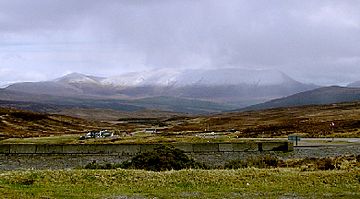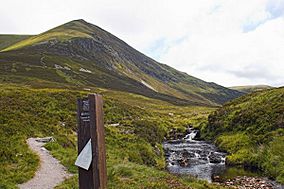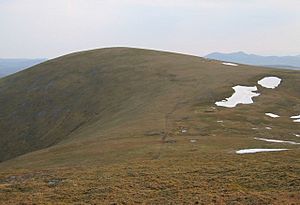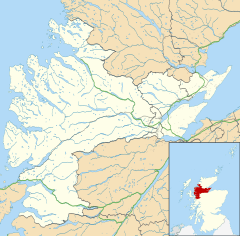Ben Wyvis facts for kids
Quick facts for kids Ben Wyvis - Glas Leathad Mòr |
|
|---|---|
| Beinn Uais | |

Ben Wyvis seen from near Loch Glascarnoch
|
|
| Highest point | |
| Elevation | 1,046 m (3,432 ft) |
| Prominence | c. 691 m |
| Parent peak | Beinn Dearg |
| Listing | Marilyn, Munro |
| Naming | |
| English translation | Hill of terror - big green slope |
| Language of name | Gaelic |
| Geography | |
| Location | Easter Ross, Scotland |
| Parent range | Northwest Highlands |
| OS grid | NH463684 |
| Topo map | OS Landranger 20 |
| Listed summits of Ben Wyvis | ||||
| Name | Grid ref | Height | Status | |
|---|---|---|---|---|
| Glas Leathad Mòr | NH463684 | 1046 m | Munro, Marilyn | |
| Tom a' Chòinnich | NH463700 | 953 m | Munro Top | |
| An Cabar | NH450666 | 946 m | Munro Top | |
| Glas Leathad Beag | NH492706 | 928 m | Munro Top, HuMP | |
Ben Wyvis (which means "hill of terror" in Gaelic) is a famous mountain in northern Scotland. You can find it in Easter Ross, north-west of Dingwall. It's part of the Highland region.
This mountain stands out with its unique "whale-back" shape. It stretches for about 5 kilometers from north to south. The highest point is called Glas Leathad Mòr, which is 1,046 meters tall. Ben Wyvis is so important that it's a special protected area for plants and birds. It's known as a National Nature Reserve (NNR).
Contents
What is Ben Wyvis Like?
Ben Wyvis is a long, wavy ridge of hills. To the south, there's a smaller hill called Little Wyvis. A mountain pass, or bealach, separates them.
You can see the A835 road and the Kyle of Lochalsh railway line near the mountain. The land to the northwest is wild and mostly empty.
How Ben Wyvis Was Formed
Ben Wyvis is made mostly of a very old rock called Moine schist. This rock formed from mud and sand about 1 billion years ago. Back then, Scotland was covered by shallow seas. Over time, the layers of sediment were squeezed and heated. This turned them into the hard, water-resistant rock we see today.
Later, huge movements in the Earth's crust folded and bent these rocks. You can still see these wavy patterns in the mountain's rocks.
During the Ice Age, thick sheets of ice covered much of Scotland. Glaciers formed in the valleys. The very top of Ben Wyvis might have poked out above the ice. You can find large rocks, called glacial erratics, that were left behind by the melting ice.
A Look at Ben Wyvis's History
Ben Wyvis sits on the edge of the historic lands of Clan Munro. Legend says the Munros promised the king a snowball in midsummer if he ever asked for one! They could do this because snow stayed in the mountain's deep hollows all year round.
A battle called the Battle of Bealach nam Broig happened near Ben Wyvis. It was fought between different Scottish clans around 1452. Clans from the northwest, who supported Clan Mackenzie, fought against clans from the northeast, including Clan Munro.
For centuries, people used to move cattle across the Scottish Highlands. Ben Wyvis was close to a major drove road. Drovers would take a shortcut across the mountain's southern slopes. This route was used even into the early 1900s. You can still see remains of old settlements and buildings that might have been used by these drovers.
Who Owns Ben Wyvis Today?
Today, the southern and western parts of Ben Wyvis are owned by NatureScot. This is where the Ben Wyvis National Nature Reserve is located. The northern and eastern parts are a privately owned sporting estate. Some lower slopes are covered in trees and owned by Forestry and Land Scotland.
In Scotland, people have a "right of responsible access" to most land. This means you can go walking, cycling, horse-riding, and wild camping on the mountain. This is allowed whether the land is public or private, as long as you follow the Scottish Outdoor Access Code.
Nature and Wildlife
| Beinn Wyvis National Nature Reserve | |
|---|---|
|
IUCN Category II (National Park)
|
|

View of An Cabar from the entrance to the NNR
|
|
| Location | Easter Ross, Scotland |
| Area | 23 km2 (8.9 sq mi) |
| Established | 1982 |
| Governing body | NatureScot |
| Ben Wyvis National Nature Reserve | |
Ben Wyvis is home to over 170 kinds of plants! You can find rare plants like dwarf birch and alpine foxtail. The top of the mountain is covered in a special mossy "carpet." This is one of the biggest areas of this habitat in Britain.
The woolly hair-moss on the summit is very important. It provides perfect nesting spots for dotterel birds. These birds come to breed here every summer. Ben Wyvis is home to at least 2.4% of all dotterel in Great Britain!
You can also see many types of butterflies, like the pearl-bordered fritillary. Dragonflies, such as the golden-ringed dragonfly, also live here. Other birds include Ptarmigan, golden plover, and even birds of prey like peregrine falcons and golden eagles.
Many deer live on Ben Wyvis, especially red deer. You might also spot sika deer and roe deer near the woodlands. Mountain hares live on the open slopes, and pine martens can be found in the forests. To keep the plant life healthy, the number of deer is managed each year.
Ben Wyvis National Nature Reserve
The Ben Wyvis National Nature Reserve covers the western and southern parts of the mountain. It also includes the high summit plateau of Glas Leathad Mòr. NatureScot manages this reserve.
The reserve has many important habitats for wildlife. These range from small woodlands on the lower slopes to moorland and rocky areas higher up. The reserve was created in 1982 and has been adjusted a few times since then. It's a very important protected area for nature.
Visiting Ben Wyvis
Most people climb Ben Wyvis from the west. You can start near Garbat on the A835 road, where there's a car park. The path goes through a forest and then into the National Nature Reserve. It gets steeper as you climb towards An Cabar, one of the southern peaks.
There's also another path that leads to Tom a' Choinnich, a peak north of the main summit. You can even combine these paths to make a circular walk.
Because Ben Wyvis is so popular, some parts of the main path have become worn down. The mossy ground on the summit is easily damaged. Since 2011, NatureScot has been working to fix these paths. They are using traditional building methods and also trying new ways to help the plants recover.
In the 1980s, there were ideas to build skiing slopes on Ben Wyvis, but this never happened.



